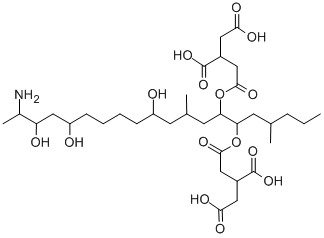| Description | Fumonisin B1 (116355-83-0) inhibits ceramide synthesis (sphinganine N-acyltransferase), IC50 = 100 nM. Inhibits de novo sphingolipid biosynthesis (IC50 = 0.7 μM) thereby blocking glycosphingolipid production. |
| Chemical Properties | white to tan powder |
| Uses | Fumonisin B1 is a major analogue of a family of potent mycotoxins produced by various Fusarium species, associated with animal toxicity worldwide. In vitro, fumonisin B1 inhibits sphingosine N-acyl-transferase (ceramide synthase) and blocks the growth of axons. |
| Uses | A serine/threonine phosphatase inhibitor. |
| Uses | A mycotoxin produced by mold associated with corn. Fungal metabolite believed to cause leukoencephalomalacia in horses. |
| Definition | ChEBI: Fumonisin B1 is a diester that results from the condensation of the 1-carboxy groups of two molecules of propane-1,2,3-tricarboxylic acid with hydroxy groups at positions 14 and 15 of (2S,3S,5R,10R,12S,14S,15R,16R)-2-amino-12,16-dimethylicosane-3,5,10,14,15-pentol. It has a role as a metabolite and a carcinogenic agent. It is a fumonisin, a primary amino compound, a diester and a triol. It is functionally related to a (2S,3S,5R,10R,12S,14S,15R,16R)-2-amino-12,16-dimethylicosane-3,5,10,14,15-pentol. It is a conjugate acid of a fumonisin B1(3-). |
| General Description | Fumonisin B1 is a neurotoxin and a phytotoxin. A cell-permeable mycotoxin that inhibits sphingolipid biosynthesis in rat kidney and in liver microsomes by inhibition of sphingosine N-acyltransferase (ceramide synthase) (IC50 = 100 nM). Cellular effects also appear to be induced by micromolar levels of FB1. Because it inhibits ceramide synthase activity, it elevates cellular levels of sphingoid bases, including sphinganine, resulting in overall inhibition of sphingolipid biosynthesis. Preferentially inhibits sphingomyelin biosynthesis in neuronal cells. Has carcinogenic properties. |
| Biological Activity | Mycotoxin produced by Fusarium moniliforme . Potently inhibits sphingosine N-acyltransferase (ceramide synthase), causing an accumulation of sphingoid bases (IC 50 ~ 75 nM). Also inhibits protein phosphatases; IC 50 values are 80, 300, 400, 500 and 3000 μ M for PP5, PP2C α , PP2A, PP1 γ 2 and PP2B respectively. |
| Biochem/physiol Actions | Fumonisin B1 acts as a hepatocarcinogen and causes hepatotoxicity in rats. In horses, it causes leukoencephalitis, and in pigs, it causes pulmonary edema syndrome. In China and southern parts of Africa, it is linked with high incidence of esophageal cancer in humans. It acts as an inhibitor of sphingosine N-acyltransferase enzyme (ceramide synthase), related to structural similarities between fumonisin B1 and sphingoid bases like sphingosine. |
| References | 1) Merrill et al. (1993), Fumonisin B1 inhibits sphingosine (sphinganine) N-acyltransferase and de novo sphingolipid biosynthesis in cultured neurons in situ; J. Biol. Chem., 268 27299 |
